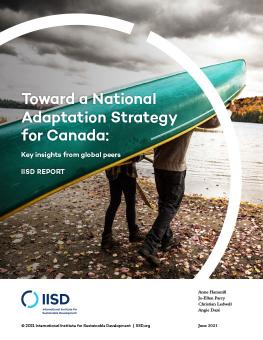
Toward a National Adaptation Strategy for Canada: Key insights from global peers
In December 2020, Canada's federal government announced its commitment to developing Canada's first-ever national adaptation strategy (NAS). In doing so, it joined the ranks of numerous countries that have initiated, developed, reviewed, and updated national strategies and plans to reduce the vulnerability of their countries to the impacts of climate change. While recognizing that Canada's NAS will need to be tailored to its unique governance structure and adaptation needs, the federal government can learn from global good practice to design a process that will produce an ambitious and inclusive adaptation strategy-one that protects and prepares Canadians for a changing and increasingly uncertain climate.
-
Severe weather events in 2020-one of the warmest years on record-caused CAD 2.4 billion in insured damage in Canada, the fourth highest annual damage on record (Insurance Bureau of Canada, 2021).
-
Countries around the world have taken steps to embed adaptation in policies and decision-making, with 72% of countries having adopted at least one national-level adaptation planning instrument-such as a plan, strategy, policy, or law-while another 9% are in the process of developing one.
-
Defining institutional arrangements is essential to adaptation action. Clearly establishing roles and responsibilities ensures coordinated action horizontally at the national level as well vertically with sub-national actors.
This report, Toward a National Adaptation Strategy for Canada: Key insights from global peers, outlines some key issues and considerations that can help the federal government kick-start the development of Canada’s NAS.
The aim is to provide context and direction for the process so that the federal government can quickly get started. It reviews the global trends in adaptation planning, summarizes federal adaptation efforts to date, and builds on both to lay out some of key considerations for Canada’s NAS. International experience and good practices identified were drawn from an examination of 12 adaptation policy instruments from 11 countries, in combination with key informant interviews. The policy instruments were assessed in terms of the emphasis on scientific assessments of climate vulnerability and risks, the use of detailed frameworks for prioritizing risks and adaptation solutions, the number of defined adaptation actions, the inclusion of adaptation targets and indicators, references to progress reporting, and the degree to which they addressed social inclusion. The country review revealed that:
- Legislative backing for adaptation action at the national level is on the rise, with more countries adopting laws in recent years.
- Iterative adaptation planning is taking place, with more than half of the policy instruments examined having recently been updated or are about to be updated.
- Most countries reviewed have codified who is responsible for coordinating adaptation action at the national level and between jurisdictions.
- Many countries have defined cycles of climate risk assessment, planning, implementation, and review, and most countries articulate a clear process and timeframe for progress reporting.
- Almost all policy instruments reference social inclusion issues, but very few emphasize matters such as gender equality regularly and throughout.
Reflecting on the current state of adaptation policies, institutions, and knowledge resources in Canada, along with findings of the international review, the report offers 13 mutually reinforcing considerations divided into four main aspects for Canada as it develops its strategy. These are:
1. Set the stage for a successful NAS development process
- Define the exact role and purpose of the NAS
- Specify clear institutional arrangements for the NAS
- Build an inclusive and progressive engagement process
2. Include core elements for mobilizing federal action on adaptation
- Develop a unified approach to climate risk assessment at the national level
- Enable policy alignment around climate-resilient development
- Leverage the NAS to advance reconciliation with Indigenous Peoples in Canada
- Design a clear framework and system for tracking progress in adaptation
3. Facilitate early and sustained action
- Bridge the implementation gap
- Create a knowledge management strategy
4. Position Canada as a leader on adaptation
- Put gender equality and social inclusion at the heart of Canada’s approach to adaptation
- Recognize the employment and labour aspects of adaptation
- Elevate the role of nature in managing climate risks
- Address adaptation issues outside of Canada’s borders
With these considerations in mind, the federal government can work with other governments and key stakeholders throughout Canada to develop a unified vision and approach to preparing and protecting Canadians against the accelerating impacts of climate change.
You might also be interested in
For Nature-Based Solutions to Be Effective, We Need to Work with Indigenous Peoples and Local Communities
Nature-based solutions have been praised as a promising approach to tackling the twin crises of climate change and biodiversity loss. But some Indigenous Peoples and local communities are questioning the legitimacy of the concept and what it symbolizes. It is time to listen to what they have to say.
How Can We Work With Nature to Tackle Drought and Desertification?
Drought is one of the most devastating and pervasive challenges exacerbated by climate change. However, we can work to reduce its effects through nature-based solutions for land restoration and climate-smart agriculture.
Canadian Youth Want to See Stronger Climate Policy in 2024
IISD takes a look at the Canada's Local Conference of Youth demands for policymakers after COP 28.
The Cost of Fossil Fuel Reliance
Government support for fossil fuels reached at least USD 1.5 trillion in 2023, new data shows.